Aucuba: description, home care and reproduction
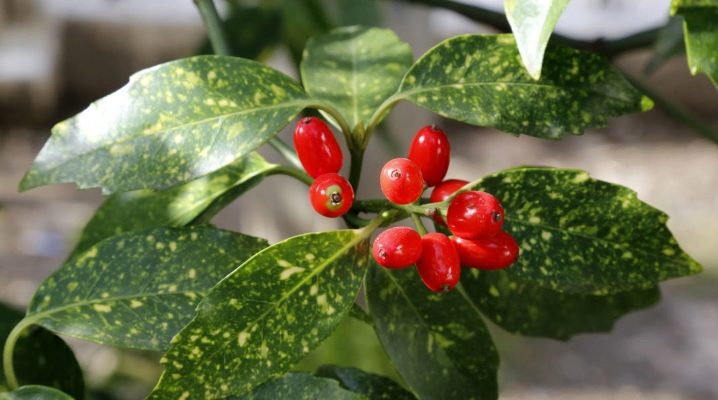
Aucuba is a rather unpretentious plant, often used to decorate an apartment. A laconic bush with variegated leaves fits perfectly into any interior.
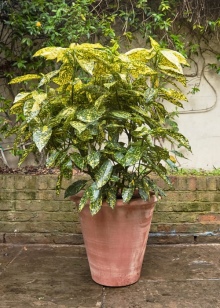
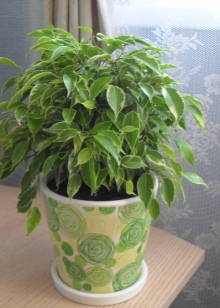
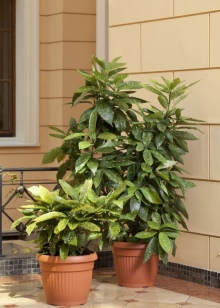
Peculiarities
Aucuba, also often referred to as the "golden tree," is familiar to many growers as a houseplant or greenhouse plant. It looks unusual thanks to its beautiful leaves covered with golden spots. In nature, it develops in the territories of eastern countries - South Korea, China or Japan. Although there are about a dozen types of aucuba, it is customary to choose only 2 of them for home use - Himalayan and Japanese.
The Himalayan aucuba reaches 4 meters in height and is characterized by the presence of leaves with teeth. On the Japanese aucuba, long 20-centimeter leaves appear, monochromatic or covered with specks.
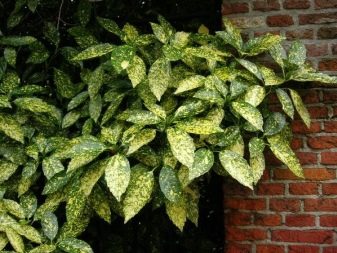
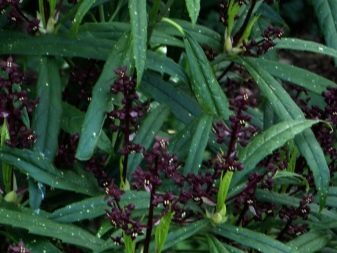
A general description of the aucuba species suggests that the culture can be like a tree or a shrub. If you do not carry out regular pruning, then the maximum height will be 1.5-2 meters. For a year, the "golden tree" grows 15-20 centimeters. In indoor conditions, the aucuba can live for about 10 years. Leathery leaves grow oval or slightly elongated.
The glossy surface is painted green or red-brown. In some varieties, it is covered with a scattering of yellow specks of various sizes and shapes. The aucuba flower is colored red. Small buds form apical inflorescences. Fruiting is carried out using red or orange berries.
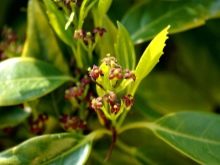

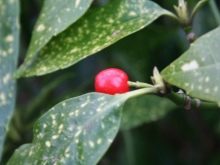
Views
Aucuba Japanese variegated, it is also variegated, has woody shoots, painted green. The leaves are oval-shaped and covered with a glossy skin. The edge of the leaf can be either solid or with teeth. The length of one plate reaches 20 centimeters and the width is 6 centimeters. Their color can be either monochromatic or spotted. Solid red flowers are collected in a kind of tassels. The fruits grow in the form of orange and red berries.
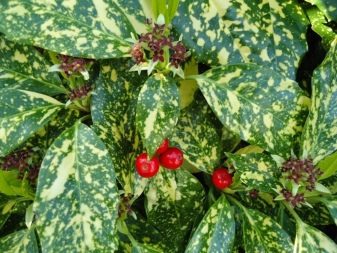

Aucuba Himalayan naturally grows up to 3 or 4 meters. The leaves are dark green and usually have a solid edge. The shape can be oblong, elongated, or pointed. The flowers are unisexual, both male and female specimens can be found on the same bush.
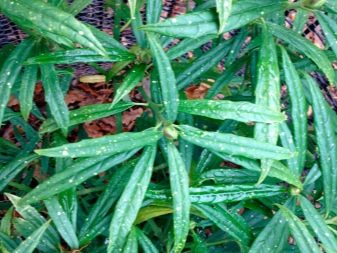
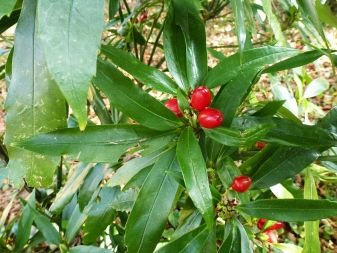
Growing conditions
In order for the aucuba to develop successfully, it, like any other plant, needs to create suitable conditions.
Houses
Lighting should be sufficient, but diffused. Moreover, the tree will have to be protected from direct sunlight, otherwise the sheets will suffer from burns. In principle, the aucuba is capable of evolving even with partial shade. In winter, the amount of light should also be normal - you will have to use additional fluorescent lamps. In the warm season, the plant feels good. at a temperature of 20 degrees. Its increase will lead to the fact that the shrub grows and begins to lose leaves.
The rest period is carried out at a temperature of 8 to 14 degrees. A decrease in the indicator below 5 degrees will lead to the death of the plant. If wintering is carried out in a well-heated room, then the leaves will additionally have to be moistened by spraying from a sprayer.The liquid must be heated and free of impurities.
You should act carefully, since at low temperatures, exposure to water leads to rotting of the roots and blackening of the leaves.

The most suitable soil mixture is a mixture of leafy soil, clay-turf, peat and sand. The components are taken in a ratio of 2: 6: 2: 1. Alternatively, you can mix the sheet soil, peat, turf, humus and sand, which are used in a ratio of 1: 1: 2: 1: 1. It is not forbidden to mix the components in equal parts. Some growers prefer to develop aucuba hydroponically.
In the open field
The conditions for growing aucuba in the garden are not very specific. The place should be well lit, but not exposed to direct sunlight. Protection from precipitation and strong winds is also important.
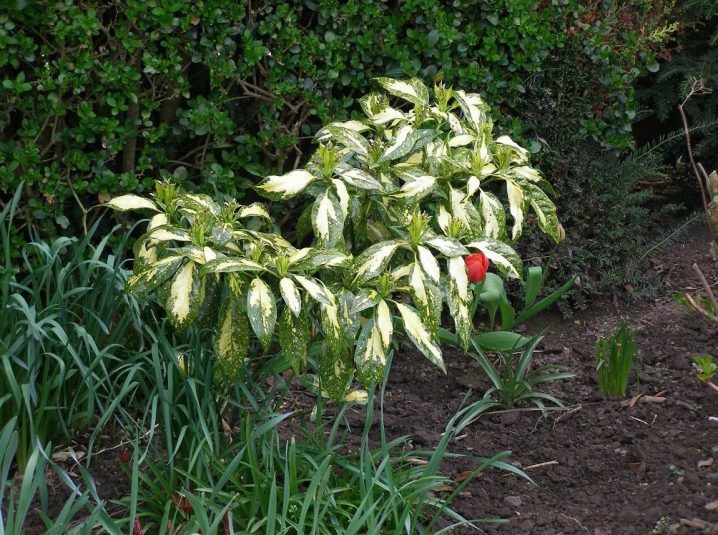
How to care?
Caring for a plant at home includes basic processes such as fertilizing, irrigating, and pruning. However, it should be remembered that the plant is poisonous, so work must be carried out using protective equipment.
Top dressing
Fertilization is carried out from spring to summer, during a period when the plant is actively developing. Feeding Aucuba Enough once a week. Both humate-based organic matter and mineral fertilizers are suitable - it is best to use them alternately. The dosage and consumption of substances should be taken from the instructions attached to the package. Any top dressing is combined with irrigation. While the aucuba is at rest, no fertilization should be applied.
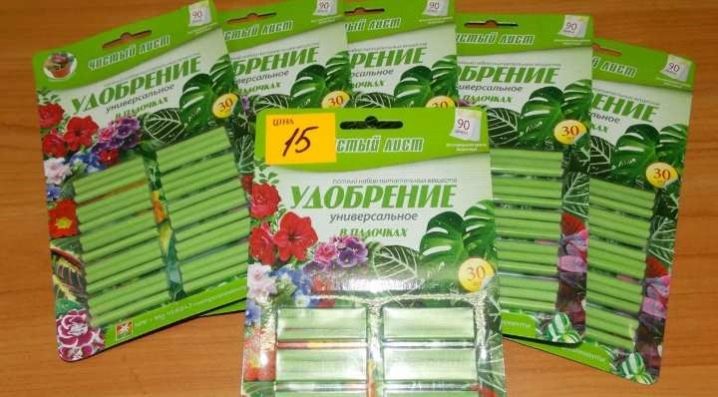
Watering
Watering the aucuba should be done heartily throughout the spring and summer. The frequency is determined by the state of the topsoil - as soon as it is dry, irrigation can be carried out. Its height is 2-3 centimeters. During the autumn-winter period, the amount of moisture used decreases.
The water should be settled and warm. It is important to mention that the plant copes with temporary drought, but reacts very poorly to stagnant moisture in the soil.
Pruning
The formation of the crown is carried out in March, when the dormant period of the aucuba ends. Such pruning has a more decorative function, since the shoots are cut off at the top, and the lateral young shoots are also pinched. As a result, the bush takes on a more beautiful shape, as well as splendor. Cut off shoots, by the way, can be used immediately for propagation by cuttings.
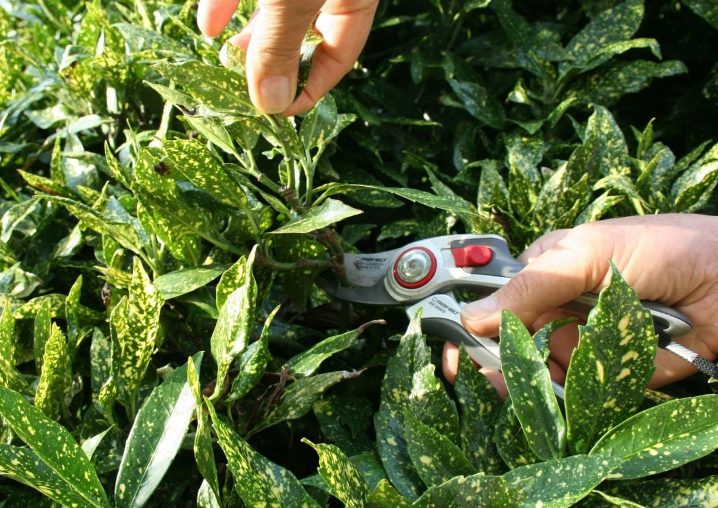
Transfer
It is better to replant the plant in the spring. For young bushes, this procedure is carried out every 12 months, and once every 2-3 years it will be enough for mature ones, as needed. Aucuba should be transferred with great care so as not to damage the roots. It is more convenient to carry out this by the transshipment method, in which the earthen lump is preserved. The pot should be taken larger than the previous one, and always wide. After completing the transplant, the plant should be pruned and pinned at the tops of the stems.
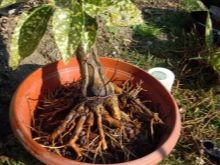
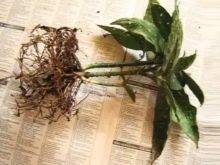
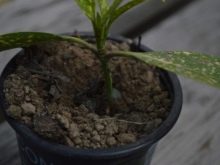
In the case when the aucuba grows to a large size, a full-fledged transplant can be changed to renew the upper layer of the substrate. Usually, to be replaced from 5 to 7 centimeters of earth. In this case, the plant can live in the same pot for up to 10 years. By the way, the larger the pot, the more the bush itself will grow. But in this case, you will have to wait decently - first, the root system will fully develop, and then the green mass will begin to grow.
During transplantation, one should not forget about the removal of rotting or already dead roots. Having cut off the parts with a pre-processed tool, the cut site will have to be processed with crushed coal or chalk. It will take 2 to 3 hours outdoors to dry.
Reproduction
Aucuba is propagated by apical cuttings or seeds. In the case of growing a pair of plants, one of which is male and the other female, artificial pollination is allowed.The seeds that have appeared can already be used for direct propagation. You will have to use the seed immediately after collecting it, otherwise the plant's ability to germinate will practically disappear. You should immediately prepare for the fact that young bushes will not be able to maintain the characteristics of the parent specimens.
The seeds are placed in a moist mixture of peat and sand. The container is tightened with cling film or covered with glass. It is important that inside the impromptu greenhouse it is preserved constant temperature of 21 degrees. Seedlings will have to be both sprayed and ventilated.
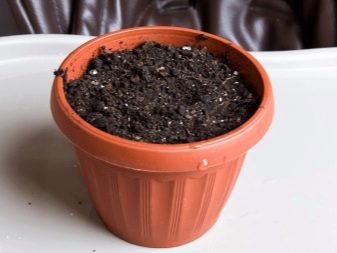
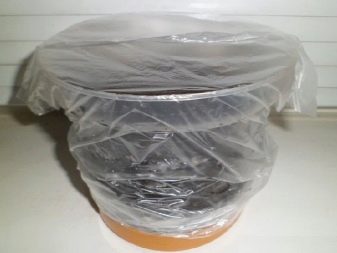
When a couple of leaves appear on the seedlings, the aucuba can be dived into individual pots.
In addition, the "golden tree" is often propagated by apical cuttings at times when there is no opportunity to use the seeds. Stems can be taken from last year's growth. Only those specimens on which a couple of leaves have already formed are suitable as cuttings. It is more convenient to root the shoots either in wet sand or in its mixture with peat. The container with cuttings is tightened with transparent cellophane.
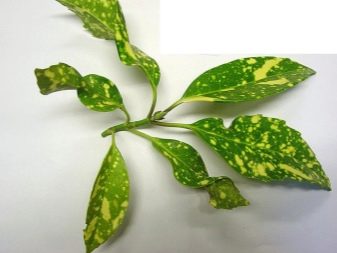
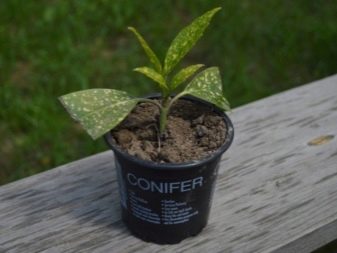
Just as with seeds, timely airing and spraying is important. The optimum temperature should range from 20 to 22 degrees. The dive takes place on pots, the diameter of which is 7-8 centimeters. As a substrate, it is better to take a mixture of humus, turf and sand, taken in a ratio of 2: 2: 1.
Diseases and pests
When there is no drainage layer at all, or it is made of poor quality, moisture stagnates in the substrate, and the leaves turn black. Further, the root system begins to rot, and the leaves become covered with black specks. The plant in this case will have to be transplanted, therefore it should not be brought to such a situation. If yellow spots, which are a characteristic feature of the aucuba, begin to disappear on the leaves, then the matter is that it lacks light and nutrition. In this case, the following will have to be done - to normalize both systems.

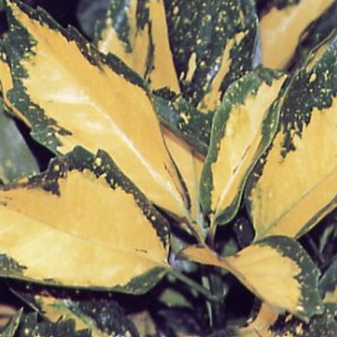
The leaves turn pale with a lack of sunshine. Treatment in this case is not necessary - just move the pot to a new place. A decrease in the size of the plates indicates that not enough fertilizer is being applied. They begin to fall off when they are in a dark room with low humidity. Full yellowing of the leaves located at the lower level of the bush indicates that irrigation is carried out irregularly, and the fluctuations between night and day temperatures are too sharp. In this case, the leaves may even fall off.
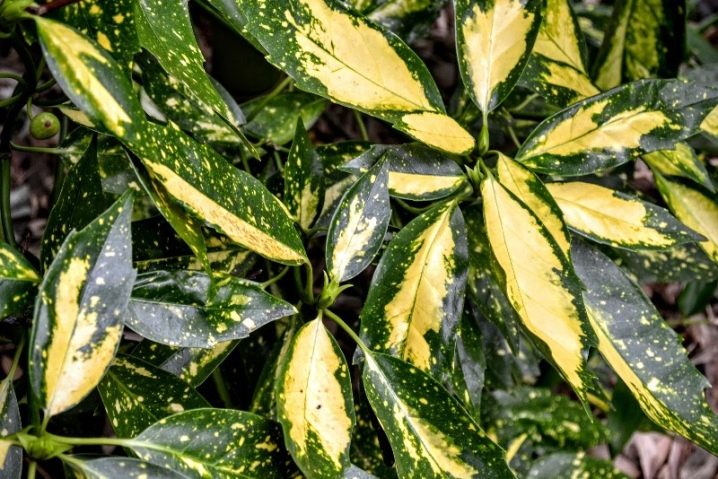
Drying tops are a symbol of excessive lighting. Dryness at the edges and fragility of the plate occurs when there is a lack of irrigation in summer and low humidity in winter. Warm and dry wintering leads to the fact that the leaves darken. Aucuba is often targeted by the scale insect. You can identify the pest by the appearance of brown bulges on the leaves, as well as yellowness. Having eliminated insects mechanically, the bush will have to be treated with a suitable insecticide.
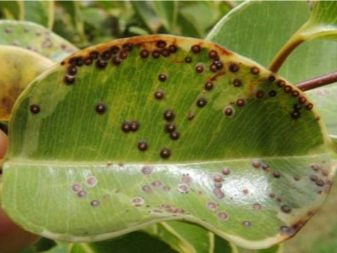
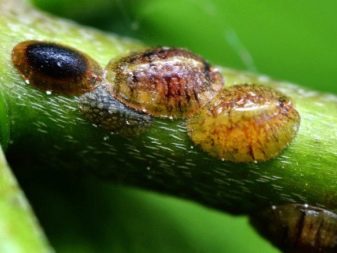
When the golden tree infects a mealybug, the leaves begin to fall off profusely. In addition, the surface is covered with bloom or off-white lumps. The plant will have to be brushed using a small brush with not too stiff bristles or a cotton pad covered with plenty of soap suds. After the aucuba, it will be enough to treat it with onion or garlic infusion. You can prepare the latter by brewing chopped cloves with a liter of boiling water.
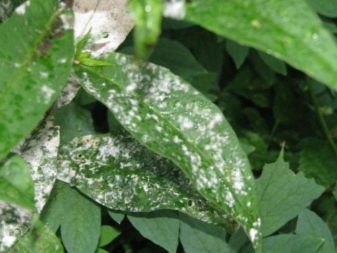
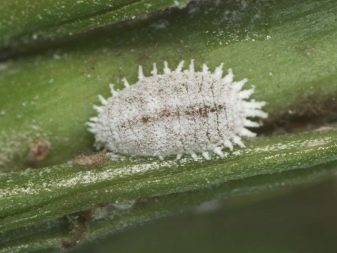
Whitefly attack leads to loss of leaf color and general weakness of the bush. To ward off insects, it will be necessary to spray the plantings with infusion of tobacco, zest or herbs with a pungent aroma. An insecticide will also help. When exposed to thrips, the leaves lose their color, change and become covered with silvery scratches. To use tobacco infusion, as well as an infusion of yarrow.
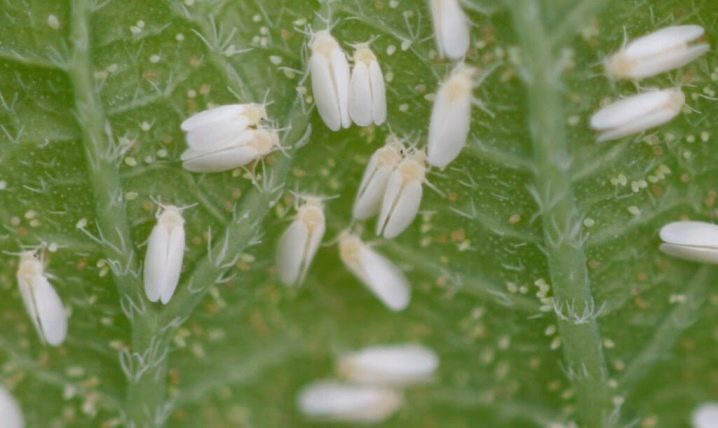
Finally, aukubu is sometimes affected by a spider mite, from which the plates fold up and become covered with a cobweb... To solve the problem, it will be enough to provide the tree with increased humidity, for example, by bathing in the shower or placing it under a plastic bag for a period of 3 to 5 days.
All about the care and breeding of aucuba at home, see the video.























The comment was sent successfully.